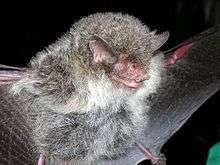Ashy-gray tube-nosed bat
The ashy-gray tube-nosed bat (Murina cineracea) is a species in the vesper bat family Vespertilionidae, found in southern Asia, including Pakistan, northern India, Burma, Thailand, Laos, and Vietnam.[1] They have tube-shaped nostrils (hence the name) which assist them with their feeding.[2]
| Ashy-gray tube-nosed bat | |
|---|---|
 | |
| Scientific classification | |
| Kingdom: | Animalia |
| Phylum: | Chordata |
| Class: | Mammalia |
| Order: | Chiroptera |
| Family: | Vespertilionidae |
| Genus: | Murina |
| Species: | M. cineracea |
| Binomial name | |
| Murina cineracea Csorba & Furey, 2011 | |
The ashy-gray bat is one of 126 new species found in the Greater Mekong region during 2011.[2] There were two other tube-nosed bats found in Southeast Asia in 2011: Beelzebub's tube-nosed bat (Murina beelzebub) and Walston's tube-nosed bat (Murina walstoni).[2] All three species are small for bats and M. cineracea is small for a Murina bat.[2] These three new tube-nosed bats were discovered by a team from the Hungarian Natural History Museum (HNHM) and Fauna and Flora International (FFI).[3] All three of these bats live in tropical forests, making them endangered by deforestation.[3]
The name "ashy-gray" comes from the color of their dorsal fur, while the ventral fur is dark gray, and there is some white fur on the breast area. In some areas the tips of the hair are dark.[2][4] It lacks the golden guard hairs so common in other members of the genus Murina.[2] This bat is small enough to fit in a person's hand, weighing 4.0 and 5.5 grams (0.14 and 0.19 oz).[2] As of 2013, there are still few details known about them and their ecology and it is suspected there are many more species of bats yet to be discovered in the region.[2]
Vespertilionid bats have many cryptic species. As an example, the members of the ashy-gray bat were formerly classified as Scully's tube-nosed bat (Murina tubinaris). Eight new species were found in Southeast Asia between 2005-2009. The use of DNA technology has proved very useful in differentiating between the various species of Murina.[2][4]
References
- "Murina cineracea - #1497". American Society of Mammalogists. 2013. Archived from the original on March 3, 2016. Retrieved June 30, 2013.
- Csorba, Gabor; Son, Nguyen Truong; Saveng, Ith; Furey, Neil M. (2011). "Revealing Cryptic Bat Diversity: Three New Murina and Redescription of M. tubinaris from Southeast Asia" (PDF). Journal of Mammalogy. American Society of Mammalogists. 92 (4): 891–904. doi:10.1644/10-MAMM-A-269.1.
- Catterick, Ally (September 2, 2011). "Three New Bat Species Discovered in Indochina". Fauna and Flora. Retrieved June 30, 2013.
- "Three New Species of Murina from Vietnam & Cambodia". Southeast, Asian Bat Conservation Research Unit. September 19, 2011. Retrieved June 30, 2013.
Further reading
- "Beelzebub's Tube-Nosed Bat Discovered in Vietnam". Space, Science, Robots. September 11, 2011. Retrieved June 30, 2013.
- "Beelzebub's Tube-Nosed Bat Discovered in Vietnam". World Wildlife Fund Australia. December 18, 2012. Archived from the original on December 30, 2012. Retrieved June 30, 2013.
- Than, Ker (September 9, 2011). "New "Demon" Bat". National Geographic. Retrieved June 30, 2013.
- Venton, Danielle (September 2, 2011). "New 'Demon' Bat Species Found in Vietnam". Wired. Retrieved June 30, 2013.
- Butler, Rhett (September 2, 2011). "New 'Demon' Bat Discovered in Vietnam". Environmental News Network. Archived from the original on September 9, 2013. Retrieved June 30, 2013.
- "New Species Found: Walking catfish, Beelzebub bat and two-legged Lizard". Telegraph. Retrieved June 30, 2013.
- "Walking Catfish, Demon Bat Among 126 New Mekong Species". Live Science. December 19, 2012. Retrieved June 30, 2013.